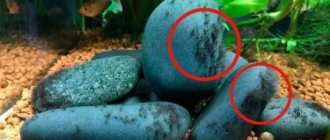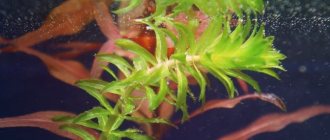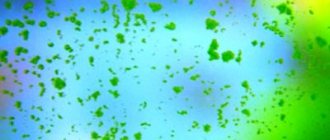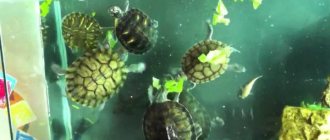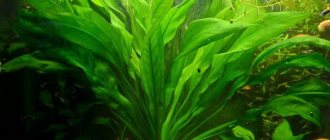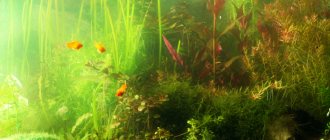Why do the plants in the aquarium turn yellow?
In the modern interior of any home, an aquarium is not only a design element, but also a source of pride for the resident and owner of the premises. Sometimes, when a person is tired of everyday worries and work, he can come home and watch carefree fish and algae - this calms and relaxes the nervous system.
But an aquarium is a design item that needs care. Sometimes the plants in the aquarium begin to rot. Below we will attempt to answer the question of why plants in an aquarium turn yellow.
The cause of this phenomenon may be the soil or lack of light. For those plants that need to be rooted in the ground, you need soil with a fraction of one and a half to three millimeters. But some plants can do without soil. For lighting it is worth using fluorescent lamps, the power of which should not be lower than 30 watts. The second reason for this problem is the quality of the water, since some of the plants are very sensitive to various chemicals contained in the water. To do this, the water from the aquarium must be purified, filtered, etc.
Lighting
One of the main factors in growing vegetation in an aquarium is lighting. Lack of light, as well as excess of light, negatively affects the growth of underwater flora, so if plants grow poorly, the first thing to do is check the operation of the lighting fixtures. Common problems are:
- The power of the light bulbs is set incorrectly, without taking into account the capacity of the tank. The error can be corrected by correctly calculating the level of performance and installing fluorescent light bulbs.
- The incorrect radiation spectrum in the tank is also the reason why algae does not grow in an artificial pond. To carry out photosynthesis, the green inhabitants of the aquarium need radiation in the orange-red spectrum.
- The depletion of light bulbs leads to a change in the radiation spectrum, which is not suitable for growing vegetation. To avoid slowing down the growth of flora, aquarists should regularly replace lamps.
Aphid
Floating plants, such as pistia or water hyacinth, can harbor aphids and feed on their sap. To quickly get rid of it, you need to transplant the affected samples into a jar of water. Prepare a solution separately: 1 liter of water, 1 g of copper sulfate, 20 g of green soap. And spray the surface with this solution. There is another way: pour 1 teaspoon of garlic peel with a glass of boiling water and leave for 3 days.
Take care of your plants by regularly changing the water and cleaning the soil. Maintain biological balance. Apply fertilizers and fertilizers containing a full range of essential micro- and macroelements. By creating conditions close to natural, you thereby ensure their normal growth, development and reproduction.
Water parameters
Some plants need a certain water hardness. For example, Blixa can only grow in soft water; in hard water, plants begin to dissolve . Other plants only grow in hard water and are affected by soft water in the same way (most Cryptocoryne species). Therefore, you need to read about the plants that inhabit your aquarium and find out if any of them are particularly demanding. Maybe these are the only plants that have problems.
Plants can also dissolve when there is a sudden change in water parameters or when there is an increased content of ammonia or nitrites in the water.
Effect of light and temperature
In low light, plants become pale in color and lose their lower leaves. They try to get closer to the light, their internodes stretch out, their stems become thinner, and they shed their leaves at the bottom. In this case, you need to see if other plants in the aquarium are taking up too much light, and thin them out if necessary. You can also make the lighting more powerful.
If your plants have unusually small leaves, it means they are not getting enough light and need feeding. If the red part of the spectrum of the lighting lamp is too powerful, the upper parts of the leaves may become elongated.
Don't forget that the higher the temperature in the aquarium, the more lighting it needs. If the ratio of light and water temperature is disturbed, plants develop long internodes and small leaves.
Water temperature plays a huge role. Just like fish, when the temperature drops, the plant can “freeze” and die. At elevated temperatures, all processes in the plant body are accelerated and require an influx of significantly greater amounts of nutrients, including carbon dioxide, which, in turn, increases the need for brightness of lighting for the processes of photosynthesis.
Light
The first commandment of every aquarist is that the aquarium lighting should be at least 0.5 watts per liter of water. If the height of the aquarium is more than 40 cm, then the lighting should be more powerful. Many plants require even more powerful lighting, at least 1 watt per liter. Experienced aquarists advise using a different calculation: 30-50 lumens (lm) per liter of water, for this you will need to find out the brightness of your lamps or LEDs. It is desirable that the light from the lamps be white.
If the lighting in the aquarium is weak, aquarium plants grow poorly, get sick and may die.
What it is?
The green coating is a colony of algae. The most common of them are protococcus (Chlorococcum), “green dust” (Green dust algae), and xenococcus (Choleochaete orbicularis). The first forms a coating only on the inside of the glass, the second - on the glass and the surface of the water, and the third - on the glass and leaves of aquarium plants.
Reference .
The name “green dust” is taken not from the scientific lexicon, but from the jargon of aquarists. There is no exact data on which types of algae form such a coating. Algae are part of the natural microflora of the aquatic environment and are always present in it . Problems appear when normal conditions are violated - algae begin to multiply too actively. More precisely, they form spores. Typically, single-celled plants reproduce by division, and this happens slowly. If the natural balance is disturbed, then one cell forms up to 32 spores, and from each a new organism appears. Reproduction is rapid in nature.
Is it dangerous?
Protococcus and “green dust” are not dangerous for fish , aquatic plants and other inhabitants of the aquarium, but they spoil the appearance of the living area. Xenococcus, which is deposited not only on the walls and surface of the water, but also on the leaves, causes harm to aquarium plants.
The benefits of moisture-loving flowers for humans
Excessive dry air is harmful to our respiratory organs. Everyone feels this for themselves. The normal level of air humidity in the room will be between 40 and 70%. In winter, dryness becomes critical. Trying to correct the situation, we buy expensive air humidifiers that do not decorate our interior at all. But there is a wonderful way to achieve comfortable humidity in a natural and beautiful way - by growing semi-aquatic or aquatic plants.
Houseplants growing in water have a romantic, fantastic appearance and lush greenery. Such an area with lush greenery, and even in combination with well-chosen photo wallpapers, will create a real tropical kingdom in the apartment. Any indoor flowers cleanse the atmosphere of the apartment and enrich it with oxygen. True, cacti and other succulents do this to a lesser extent. But tropical swamp plants have powerful photosynthetic activity. All physiological processes occur energetically in them, so they can supply us with oxygen and moisture to the maximum.
Recently, decorating the bathroom with living plants has become popular. Moisture-loving plants are ideal for this purpose. They will grow beautifully here. And while taking a shower or bath, you will feel as if you are on a tropical ocean coast.
Micronutrient imbalance
Iron
Symptoms of deficiency: leaves turn pale, shoots become transparent, the color of plants with red leaves fades.
Method of treatment: application of ferrous iron complex compounds or 0.1−0.2 mg/l of ferrous sulfate every 1−2 weeks.
Symptoms of excess: leaf blades turn pale, only the veins remain green.
Method of treatment: weekly water changes.
Bor
Symptoms of deficiency: growing points turn black and die, young leaves become smaller and distorted, roots die.
Method of treatment: application of 0.2 mg/l of borax or boric acid every 1-2 weeks.
Symptoms of excess: leaves bend dome-shaped, turn yellow, starting from the edges, then die, in severe cases, the growing points turn black.
Method of treatment: regular water changes.
Copper
Symptoms of deficiency: the entire leaf blade turns pale evenly, the plant may begin to branch heavily.
Method of treatment: application of 1.5−0.2 mg/l of copper sulfate once a week.
Symptoms of excess: pale spots appear between the veins on young leaves, brown spots appear on old leaves, the plant loses leaves, starting from the lower ones.
Method of treatment: change the water more often, stop adding copper sulfate.
Prevention measures
Even knowing the causes and consequences, having identified and eliminated the culprit in the death of aquatic plants, none of their aquarists are immune from a repeat situation.
To minimize the risk of subsequent death of your aquarium flora, you need not only to know exactly why the plants in the aquarium are dying. Preventive measures become important.
Namely:
- provide the jar with light of such intensity that it is scattered over the surface of the water and penetrates into its depth up to 50-60 cm;
- Make sure that the water hardness does not exceed 15-20 mg/l;
- do not forget to do regular water changes;
- constantly siphon the soil (at least 1-2 times weekly);
- place several varieties of aquatic plants in your home water area;
- determine the compatibility of fish and plants before settling them (the most peaceful fish that do not harm the flora include young ancitrus catfish, moths, corydoras, labeo, platies, girinocheyls, guppies);
- do not overfeed your pets, give them only as much food as the fish can completely eat in 2-3 minutes;
- Before introducing a new plant into an existing aquarium, first keep it in quarantine (2-3 weeks).
And remember that plants are different, they have different periods of adaptation to new conditions. Therefore, do not draw premature conclusions that the plant died when transplanting it into a new aquarium. Observe for a few weeks to see how it is doing.
Knowing why plants die in an aquarium, you can accurately eliminate the cause of the problem.
Better yet, first make a to-do list for caring for your home water area and follow it. Only with the right and competent approach will your aquatic ecosystem always be in perfect order, and your aquarium plants will delight you with beauty and splendor.
Yellow spots appear on the surface of the leaves, the edges begin to fade
This indicates a lack of potassium. Every plant needs it because it is a catalyst for growth. In aquarium conditions, it does not get into the water with changes. Therefore, if you do not add it, the problem will definitely remind you of itself. But her solution is quite simple. It is enough to purchase fertilizer at the pet store, namely potassium monosolution. It is often applied weekly, after changes.
If there is no desire or opportunity to buy parole, then you can prepare it yourself. To do this, you need distilled water and a solution of potassium sulfate. It is mixed with the distillate and boiled. After brewing a little, the homemade fertilizer can be considered ready.
Main representatives
Cyperus
Cyperus
This is the most famous and unpretentious of indoor aquatic plants. Its triangular, strong stems, growing in a bunch, end in a lush “fountain” of leaves spreading to the sides. For such a characteristic appearance, Cyperus is often called “palm tree”. In fact, he belongs to the Osokov family. Its homeland is the wetlands of tropical Africa. Its closest relative is papyrus. And our pet is often called by a double name: Cyperus-Papyrus. This plant can be grown simply in a container of water. There is never too much water for him. The more it is, the more magnificent it grows. It is usually grown in flowerpots that stand in deep trays that are constantly filled with water.
Calla
Calla, or calla lily
The second most popular indoor plant, preferring to grow almost submerged in water. This marsh plant came to us from the subtropical regions of South America. Its charming snow-white blanket surrounding the bright yellow ear of the upward-pointing inflorescence looks solemn and elegant. Pots with calla lilies, like cyperus, feel best when placed in trays filled with water. The popularity of the flower is associated not only with its magical beauty, but also with the significant plasticity of the plant. Calla lilies can also grow in conditions of relative lack of moisture. True, in this case you can’t count on lush flowering.
Lack of phosphorus and potassium
Phosphorus. Signs of phosphorus starvation are darkening of the color of young leaves, curling of leaves and shoots, and the appearance of brown and reddish-brown spots on old leaves.
Calcium, potassium and magnesium salts of orthophosphoric acid are most often used as phosphorus fertilizers.
When signs of a lack of minerals appear, complex fertilizers, which contain phosphorus, are also added to the water.
Potassium. Potassium deficiency is usually expressed in the appearance of brown and yellow spots on the edges of leaves. You can use complex mineral fertilizer nitrophoska. It contains the most essential macroelements - nitrogen, phosphorus, potassium - in an optimal ratio for plants.
This mineral fertilizer can be added to the aquarium at every water change. The usual dosage is from 1 to 2 g per 100 liters of water.
Phosphorus. Signs of phosphorus starvation are darkening of the color of young leaves, curling of leaves and shoots, and the appearance of brown and reddish-brown spots on old leaves.
Calcium, potassium and magnesium salts of orthophosphoric acid are most often used as phosphorus fertilizers.
When signs of a lack of minerals appear, complex fertilizers, which contain phosphorus, are also added to the water.
Potassium. Potassium deficiency is usually expressed in the appearance of brown and yellow spots on the edges of leaves. You can use complex mineral fertilizer nitrophoska. It contains the most essential macroelements - nitrogen, phosphorus, potassium - in an optimal ratio for plants.
This mineral fertilizer can be added to the aquarium at every water change. The usual dosage is from 1 to 2 g per 100 liters of water.
Nutrient deficiencies
Plants grow poorly, plant leaves turn yellow , starting from the edges, old leaves turn yellow prematurely and die. All this may be a sign of a lack of a substance such as nitrogen. Usually in a densely populated aquarium this problem rarely occurs, nitrogen gets into the water along with fish food and their feces, but it still happens. In this case, additional fertilizer will need to be applied.
Brown or reddish-brown spots on old plant leaves , young leaves darken or turn black, curling of leaves or shoots - these signs indicate a lack of phosphorus, also an essential substance for plants.
Brown and yellow spots on plant leaves, poor growth, leaf dissolution, curling - all these signs may indicate a lack of potassium. Typically, potassium is supplied to the aquarium with fresh water during water changes and with fish food, but potassium never hurts plants for good growth, especially since its excess does not cause algae growth.
The plants in the aquarium turn yellow or have a pale green color - this indicates a lack of iron.
White spots between the leaf veins followed by tissue decay indicate a lack of magnesium in the aquarium.
There are a number of other signs that may indicate a lack of some micro element in the aquarium, but this is very rare. Usually, eliminating all of the above problems gives a positive result, the plants acquire bright colors and begin to grow quickly.
It happens that a change in the color of the leaves may indicate that one of the types of algae has appeared on the plants. Plaque appears especially often on the leaves of a plant such as anubias. In these cases, you need to start fighting against algae.
Diseases associated with algae
Blackbeard algae is the most common disease. They face it the most. This algae in the form of black hairs settles not only on the walls of the aquarium, but also on the vegetation. In addition to the ugly aesthetic appearance, it significantly slows down growth.
How to get rid of it? Mechanical cleaning should be carried out using a stiff brush. In case of severe disease damage, it is better to replace the vegetation with fast-growing ones. Floating plants can be kept in a solution with hydrogen peroxide at the rate of 1 ml per liter of water.
Red algae (purple algae). A sign of scarlet blight is the appearance of small tufts or individual red hairs on the leaves. As a rule, this sore appears in cold-water aquariums. Catfish and ancistrus help in the fight against it.
Blue-green algae. The disease begins with the appearance of dark green dots. They cover the soil, the walls of the aquarium, and sheets. Over time, the dots grow, forming a dense
crust, which is then very difficult to remove. Plants slow down and individual leaves begin to rot. There can be several reasons for the appearance of blue-green algae: unstable water, excessively strong lighting, elevated temperatures, poor aeration of water, introduction with live food.
To get rid of blue-green algae, you need to thoroughly clean the plants, walls and bottom of the aquarium. You can get inhabitants that feed on green fouling. Increasing water aeration and decreasing illumination also has a positive effect on the fight against them. As a last resort, penicillin should be used.
Signs of too much algae
You can recognize the presence of a problem by the following manifestations:
- Cloudy water a few weeks after completely replacing it.
- Green plaque on the walls of the aquarium in the form of round spots.
- Thread-like light green growths on stones.
- Change in the shape of the leaf part of aquatic plants.
- Unpleasant musty and slightly putrid odor of water.
If these signs occur, it means that the biobalance of the aquarium is disturbed. Beneficial flora is suppressed by pathogenic ones, which leads to rapid water pollution.
In the absence of action, the protozoa quickly multiply, filling the entire area of the aquarium. This depresses flora and fauna, which leads to the death of fish and rotting of plants.
Priming
The next important factor is the soil. For plants with a developed root system, the soil should have a fraction of 0.2 to 0.5 mm, no more! In coarser soil, plants' root formation and nutrition are impaired. Plants in such soil will grow very poorly, or their growth stops completely, they wither, gradually lose leaves and sooner or later die. In shallower soil, “acidification” is possible, which can also lead to negative consequences: rotting of plant roots. “Souring” or “caking” is also possible in larger soil, especially if it consists of basalt. You can check the soil for souring by moving it with a knitting needle. If at the same time bubbles are released from the soil, and they also smell bad, then this is precisely the problem. If the soil becomes acidic, only restarting the aquarium will help.
Rare aquatic plant for Russia suitable for human consumption
The answer is chilim, or water chestnut (Tgara natans). It is an aquatic plant with large greenish leaves, very similar to currant leaves. Long thin stems stretch from the leaves to the very bottom. If you lift them, then under the leaves on the stem you can see small blackish boxes with five spines. Chilim is similar in size and taste to chestnuts. The local population sometimes collects it in bags in the fall.
Chilim
In some countries, water chestnut (Tgara bicornis) is widely cultivated. Chilim can be eaten raw, boiled in salted water, baked in ashes like potatoes, or made into soup. Bread is baked from nuts ground into flour. Boiled fruits of this plant are sold everywhere in China.
Why are the plants turning yellow in my aquarium?
***Ruslana***
What does the light have to do with it! In low light, plants become pale in color and lose their lower leaves. They try to get closer to the light, their internodes stretch out, their stems become thinner, and they shed their leaves at the bottom. In hornwort, as we see, there are no such “symptoms”... By the way, hornwort is a shade-loving plant and sensitive to light... in bright light the plant dies. By the way, I found out that this plant is characterized by seasonality... you can read about it yourself https:///aqua_underwater_plants.html.. although now is not winter time, it’s still interesting... But I’m inclined to say that if there is discoloration and Yellowing of the leaves indicates iron deficiency. Maybe it’s worth giving clay fertilizer? Here you can familiarize yourself with the “causes and signs of diseases of aquarium plants” https:///viewtopic.php?f=15&t=552 How long ago did you have hornwort? Could the problem be due to the difference in water parameters in your aquarium and where these plants migrated to you from? Naturally, any radical change in living conditions leads to temporary inhibition of plants and a halt in their growth - first they turn yellow and shed their leaves, and then slowly and gradually become accustomed. Don't you have enough fish? Are these all the ones visible in the photo? It’s good if the remains of fish feed are used as a nutrient... it is advisable after planting not to siphon the soil for a month so that the rhizoid branches from the silt can receive accumulative nutritious food. But I don’t recommend resorting to various chemical fertilizers.
Ridens Verum Dicere!
If you are too lazy to change the water, use Tetra EasyBalance And if you are involved in aquarium farming, then at least study it from time to time https:///page20.htm This is not like having a kitten that you feed a couple of times a day and forget about! Good luck!
Diseases of aquarium plants: symptoms and causes, treatment. - Plants
Plants in an aquarium are not just a source of beauty; they also play a very important role in creating the microclimate in the tank. Algae absorb carbon dioxide, as well as metabolic products secreted by fish, and absorb the remains of dead plants and uneaten food with their roots. While daylight lasts, aquarium plants produce oxygen, which is necessary for the inhabitants to breathe; at night, they absorb a small proportion of oxygen, releasing carbon dioxide.
Thanks to plants, aquarists can create an environment for fish that is comfortable and close to natural conditions. If the aquarium is empty, without vegetation and shelters, the fish will have nowhere to hide, because females and fry of viviparous fish hide in the thickets of plants from males. The inhabitants become more timid and irritable; without plants, the process of reproduction of some fish is impossible, because they spawn on leaves or among thickets of plants. Also, floating and tall plants are a kind of screen that protects the inhabitants of the tank from excess light and prying eyes.
When creating a small underwater world, it is necessary to maintain biological balance: the qualitative ratio of fish and plants must be correct. The point of view: the more plants the better, is fundamentally incorrect; excess vegetation is also harmful. When choosing plants, consider the conditions in which you will plant them: the type of aquarium, its dimensions, the fish you want to place. Plants should be purchased with a bright green color, young, with an intact root system, leaves and roots. Conventionally, the number of plants can be calculated: for 2-3 square decimeters of the bottom area of the aquarium, 1 type of vegetation.
Once you have purchased your plants, inspect them carefully. Parts that are susceptible to rotting or disease must be removed, the roots cleaned of dirt and rinsed thoroughly in water. If the plant has a powerful root system, but a short stem, the roots need to be thinned out, the rest are cut to 2-3 cm. If the roots are thin and fragile, they are practically not cut off: for example, it is not recommended to touch the roots of anubias at all. For long-stemmed plants, the lower part is removed with leaves and roots (so that at least 3-4 nodes remain). If you repot plants, be prepared for them to grow more slowly as they lose old roots and it takes time for new ones to form.
Like any living, properly functioning organism, a plant can get sick. Only specialists can diagnose the disease, but aquarists, before considering a plant sick, need to make sure that perhaps it is simply damaged by fish or snails. Basically, the development of the disease is provoked by microorganisms that appear in the aquarium or by improper maintenance conditions.
The main signs of diseases in aquarium plants and how to combat them:
The reason may lie in a lack of carbon or an unbalanced acid-base balance of water. What to do: add CO2 to the water, if the problem is in PH, transplant the plant to another tank;
The reason may be too compacted fine soil, which does not allow air to pass through well. What to do: add gravel, crushed stone or pebbles to the soil;
- Small areas of the leaves die, after which the leaves fall off
The reason is a lack of phosphorus. What to do: purchase special plant fertilizers;
- Plants are pale, with long internodes and thin stems, leaves fall off at the bottom
The reason may be a lack of lighting. What to do: extend daylight hours for plants, place the aquarium in front of the window;
- Small plant leaves and excessively long internodes
This indicates a violation of the temperature and lighting conditions. Many species of fish love high temperatures, but plants also require appropriate lighting. What to do: adjust the temperature and light conditions: the higher the degrees, the longer the daylight hours;
- The upper part of the plants is very elongated in length
The reason may be increased radiation from the red spectrum of lamps. What to do: hang the lamps higher, closer to the lid of the aquarium, or purchase less powerful ones;
- Plants wither and wither, you notice partial damage, holes, frayed edges of leaves
Reason: either your fish are too active, or the chemical composition of the water is simply not suitable for the plant. What to do: feed, analyze the composition of the water;
- Damage to leaves (this is especially typical for plants with a developed root system and a small stem).
The problem can be caused by excessively dense soil, which causes water to stagnate in it. What to do: regularly “siphon” the soil, dilute it with gravel, pebbles, tuff, make it “loose”;
- Limescale deposits on leaves.
The cause of this phenomenon may be a lack of carbon dioxide. What to do: CO2 is necessary for the normal development of plants, so gradually increase its content in the water;
- Plant leaves are too small.
The plant may lack nutrients or, conversely, there may be excess lighting. What to do: try feeding, if this does not bring results, reduce daylight hours;
- Leaves turn red or yellow.
The cause may be a lack of sulfur or nitrogen. What to do: feed the plant with nutrients, experimentally finding out what, in fact, it was missing;
- Yellow edges on the leaves of the plant.
This is evidence of calcium deficiency. What to do: you can add carbonate, mollusk shells, ready-made mixtures for fertilizing plants;
- The leaves begin to wither at the edges, and yellow spots appear on their surface.
This means there is not enough potassium in the water. What to do: prepare a solution of potassium sulfate (potassium sulfate) by mixing it with distilled water, bringing to a boil and letting it sit. Add in small portions;
- Yellow spots appear between the veins of the leaf, then holes form in their place.
This is evidence of magnesium deficiency. What to do: add MgSO4*7h30 sulfate - you can buy it at a fertilizer store or pharmacy;
- The leaves of the plant turn yellow and become glassy.
This means that it lacks one of the most important elements - iron. What to do: add ferrous iron compounds, the main thing is not to overdo it, the concentration in water should not exceed 0.1 mg/l;
- The leaves are yellow, but the veins remain green.
The phenomenon may indicate both a lack of manganese and an excess of iron. What to do: manganese is needed for tissue respiration and photosynthesis, so you need to add a nutrient mixture containing this element;
- “Cryptocoryne disease” is manifested by the fact that the plant becomes glassy, the leaves are “holey”, and eventually it decomposes along with the stem.
The reasons are not yet known. What to do: cut off the leaves, suck out the remains of the plant from the soil using a hose, change the water - this way you can preserve the root system.
Restoring plants takes more than one day; to prevent diseases, regularly change the water in the aquarium, adjust the lighting, and do not overpopulate the aquarium. Remember that each plant has its own requirements for the environment and they must also be taken into account!
www.pitomec.ru
Signs of nutrient deficiency or excess
It is very important to maintain a balance of nutrients in the aquarium, because a deficiency or, conversely, an excessive amount of minerals can adversely affect its flora.
Important! The speed at which plants react to changes in the chemical composition of water can vary significantly depending on their species: some will begin to get sick after a couple of days, while others will react only after 1-2 weeks.
This can manifest itself in different ways: damage to vegetation can be almost invisible or too obvious.
We propose to take a closer look at how an imbalance of micro- and macroelements can affect the vegetation in an aquarium.
Slow growth
A lack of nitrogen can cause stunted plant growth. Nitrogen deficiency leads to yellowing of the foliage and the veins on it. The situation can be improved by lowering the temperature of the water in the aquarium and adding nitrogen to it: 10 mg for each liter of water once a week.
Check out our list of the best aquarium plants, especially the following: Rotara Macrandra, Echinodorus, Pogostemon Octopus, Helfera, Erectus, Hemianthus cubea, Sagittaria, Marsilia, Java Moss, Cryptocoryne and Hemianthus.
Leaf chlorosis
Due to a lack of iron, aquarium plants can suffer from chlorosis: their growth slows down, the foliage becomes light, curls, and then completely dies.
For favorable growth and vital activity of the flora, the iron level should be in the range of 0.1–0.2 ml per liter of water.
Increasing iron levels is quite simple - for this you can purchase special fertilizers or use copper sulfate (1 mg per 10 liters of water). If chlorosis is caused by excess iron, which can be detected as a result of the test, then a 50% water change should be performed.
Amazon chlorosis Chlorosis can also appear on foliage due to a lack of potassium - to normalize its level, this element should be added to the water at the rate of 10 mg of potassium per 1 liter of liquid.
Manganese deficiency also leads to chlorosis of leaves, especially for young shoots: they first become covered with spots, mainly at the base of the leaf blade between the veins, and subsequently die. An insufficient amount of boron can also lead to a similar disease.
Important! In order to measure the level of iron in aquarium water, you can purchase a special test at a pet store. The fact is that an excess of a microelement causes the same adverse consequences as its deficiency.
Severe darkening and curling of young leaves and shoots
Such symptoms indicate a lack of phosphorus and require immediate correction of the level of this substance in the water by adding 10 mg per 1 liter of liquid once every 7 days.
With a large lack of fluoride, brown or red spots appear on the leaves, which subsequently turn into holes, so the situation should not be neglected, and at the first suspicion of a lack of the element, its level should be checked and appropriate adjustments made.
Light spots on leaves
One of the most important elements for the favorable functioning of plants in an aquarium is magnesium. Its deficiency can lead to the appearance of light (whitish or light yellow) spots between the veins on the leaf blades.
The lower leaves of the plant are the first to suffer, and then, if the disease is not treated, it reaches the upper ones. The leaves curl at the edges and do not look aesthetically pleasing.
In order to cure vegetation, magnesium is added to the aquarium at the rate of 5 mg per 1 liter of water, the procedure is repeated every 7 days until the symptoms completely disappear. This may take from 1 to 2 months.
Did you know? A fashionable trend is the presence of aquariums without fish in the interior; they are also called “Dutch”. Home ponds are inhabited exclusively by vegetation, playing with shapes, sizes and colors.
Small light and brown spots on leaves
Small light and brown spots on the foliage of plants are an indicator of a lack of manganese - this nutrient is responsible for the absorption of iron by plants. Accordingly, therefore, the symptoms of manganese deficiency are very similar to iron deficiency.
Why do algae appear?
Normally, the microbiota (a set of beneficial microorganisms) is able to independently control the growth of protozoa, restraining their population. If a task is not completed or is performed incompletely, this is immediately evident visually. There are several reasons for uncontrolled algae growth:
- Uncontrolled daylight hours: an excess of light, as well as a lack of it, provokes the active growth of algae.
- Lack of scheduled and unscheduled cleaning: lack of time and reluctance to tinker with the aquarium every month leads to the fact that the water is not replaced properly, and leftover food, dead plants and fish begin to rot. An ideal environment is created for the reproduction of protozoa and no filters are able to control this process.
- An increase in the water temperature in the aquarium in the summer leads to acidification of the soil and accelerates the process of decomposition of bottom organic sediment. In summer, the problem of water bloom appears several times more often, so it is important to pay attention to the thermometer readings and take appropriate measures.
- Excess and lack of mineral fertilizers in the soil for plants is a proportional situation: the higher the level of phosphorus and nitrates, the more difficult it is for the microbiota to restrain the growth of algae. The lack of these substances negatively affects the beneficial microflora, which, due to nutritional deficiency, does not fully perform its filtration functions.
Experienced experts recommend organizing a “day without light” several times a month, when the aquarium remains completely without lighting. This preventive measure is detrimental to many unicellular algae, which helps maintain biobalance.
- Wrong spectrum of artificial lighting - aquarium plants need light in the red and blue spectrum for full development. Incandescent lamps emitting yellow light provoke the active growth of protozoa, so their use in aquarium farming is unacceptable.
- The predominance of natural light - if the aquarium is located on a windowsill or in that part of the living room where there is direct sunlight, a green coating on the walls and cloudiness of the water cannot be avoided.
- Lack of proper filtration or an incorrectly selected filter that does not do its job. As a result, organic particles rot, creating optimal conditions for protozoa.
Based on the reasons, the basic requirements for maintaining an aquarium are developed, which help maintain the correct balance of protozoa, preventing active overgrowth by algae.
